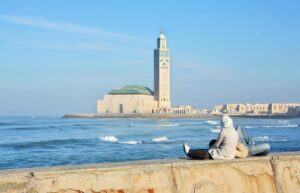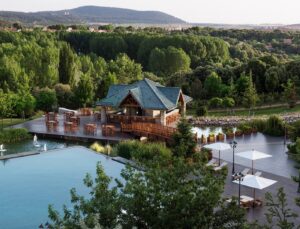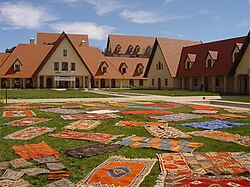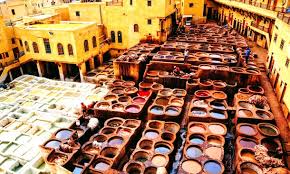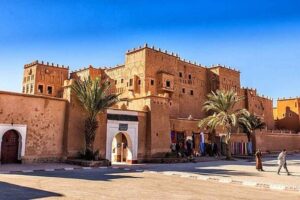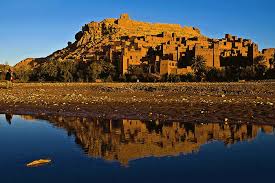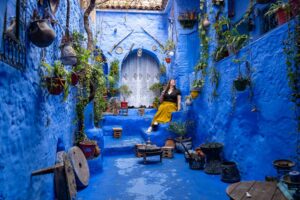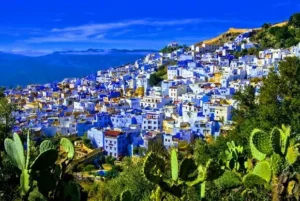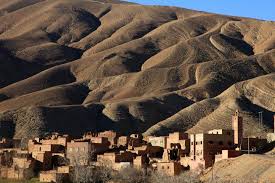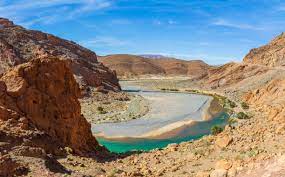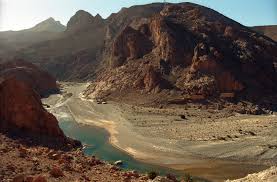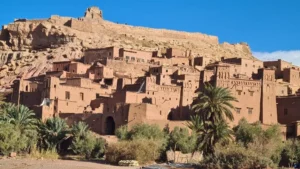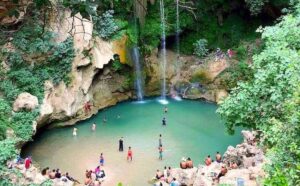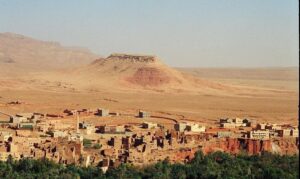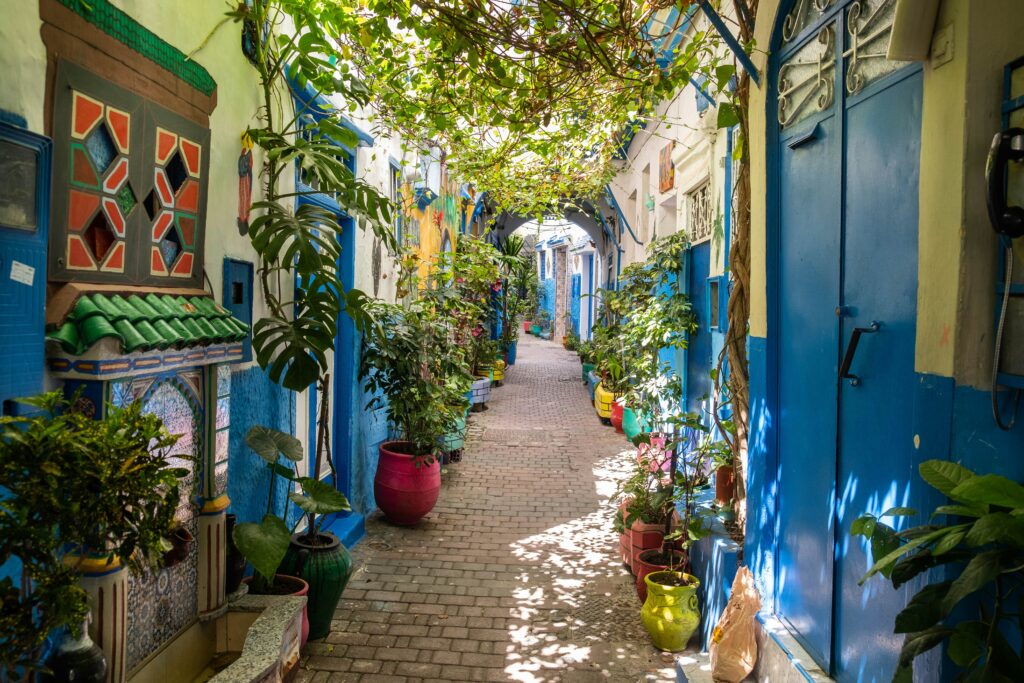- Overview
- Itineraries
- Trip Includes
- Trip Excludes
- Gallery
- FAQ
The private Moroccan Desert tour 8 days from Casablanca via Marrakech, High Atlas Mountains, Ait Benhaddou, Skoura, Dades Valley, Merzouga Desert, Fes, Chefchaouen and Tangier offers an ideal opportunity to learn about the deep-seated heritage of Morocco while enjoying the natural potentials that this amazing destination has to offer. We will meet & greet you upon arrival in Casablanca before embarking on a journey of a lifetime experience. You’ll be touring around Morocco with one of our professional private drivers who knows like the back of their hands. In cities like Marrakech, Fes & Chefchaouen you’ll have local tour guides to explore with.
Itineraries
Day 1
Casablanca — Marrakech
Meet & greet upon arrival in the Mohammed V International Airport, then head to Casablanca’s city center where the dramatic Hassan II Mosque is built by the Atlantic Ocean. It is the third-largest mosque in the Islamic World & is a unique masterpiece of Moroccan & Andalusian Architectures. Have a drive by the Ain Diab paved Corniche before heading to Marrakech through the highway.
Day 2
Full-Day Guided Tour of Marrakech
After having breakfast in your hotel, you will have a cultural guided tour of Marrakech. This mysterious city has gained a worldwide reputation thanks to the immense beauty & cultural diversity with which it has been endowed. Drive through the “Ville Nouvelle”, which was built by the French when Morocco was a French Protectorate from 1912 to 1956 to the botanical gardens of Majorelle. This haven of peace & tranquility was beautifully created by Jacques Majorelle who collected plants from all over the globe to come up with his dreamlike small paradise. Saint Laurent came later to add his unique artistic stamp offering, nowadays, the possibility to visit the Saint Laurent Museum that is located within the gardens.
Your cultural tour of Marrakech will take place from the Koutoubia Mosque (the landmark of Marrakech). The minaret covers the horizons of the pink city & its foundation goes back to the 12th century when the Almohad dynasty had conquered the Almoravid “Berber Warriors”. From the majestic Bab (gate) Agnaw, you’ll get to the Kasbah District to explore the Saadian Tombs. Then, meander around the intricate alleyways of the Mellah (Jewish Quarter) leading us to the Bahia Palace, which was built by the late Sultan Hassan I’s main vizier.
Stroll in the vibrant Souks that are divided into sections according to specialty before ending up the walking tour in the Jemaa El-Fna Square (the focal point of Marrakech). In the evening, it turns into a carnival filled with musicians, acrobats, snake-charmers, magicians, story-tellers, fortune-tellers and much more.
Day 3
Marrakech — High Atlas — Ait Benhaddou — Dades Valley
Today, you will head south crossing the high Atlas Mountainous chain that stands like a wall dividing Morocco’s south to its north. Drive through the spectacular Tizi n’Tichka Pass (2260 m), and then have a guided walking tour of the Ait Benhaddou Village. This UNESCO Listed village consists of numerous Kasbahs (fortresses) and has been used as a backdrop for shooting many Hollywood Movies including Lawrence of Arabia, Gladiator, Kingdom of Heaven, Prince of Persia and many others.
After lunch, we drive through Ouarzazate (Hollywood of Af Rica) with the possibility to include a visit to the famous Atlas Film Studios. Continue on the track further southeast through Skoura with its preserved Amredil Kasbah, then through the Valley of Roses before reaching our final destination of the day, the Dades Valley.
Day 4
Dades Valley — Todra Gorge — Erfoud — Merzouga
After having breakfast in your hotel, you’ll head to the Sahara Desert of Erg Chebbi while including a short break in the majestic Gorge of Todra (canyon) where you may want to stretch your legs while enjoying the stunning views. After lunch, you’ll drive through Erfoud is known for the dates production & fossil museums. When you arrive to the Erg Chebbi dunes, you’ll have a journey on a camel to attend the miraculous view of the sunset. Return back the desert camp for dinner followed by a time of entertainment.
Day 5
Merzouga — Ziz Valley — Midelt — Ifrane — Fez
Early wake up in the morning to attend the sunrise view atop the sand dune and after breakfast, you’ll continue on the track north to Fes through the palm-dotted Ziz Valley, Ziz Gorge, Midelt and Ifrane. You’ll include numerous stops for chilling out and for taking pictures. Lunch will take place in Midelt.
Day 6
Full-day Guided Tour of Fez
Today, you’ll spend the day exploring what Fes has to offer with your experienced tour guide. You’ll start with a drive uphill to enjoy the panoramic view of the Fes el-Bali (oldest Fes). Then, head to the Mellah (former Jewish Quarter) & Royal Palace where you can take pictures by the Golden Gates, and where you may want to stretch your legs in the vibrant street of the Mellah before getting inside the large old Medina of Fes.
Fes el-Bali is listed by the UNESCO as a World Heritage Site & is the largest car-free district in the world. The only means of transportation is mules and donkeys. The vibrant Souks and the bustling cafes along the historical monuments are what you can expect to come across.
Day 7
Fez — Chefchaouen
After having breakfast, you’ll head to Chefchaouen through the Rif Mountains. Upon arrival, you will embark on exploring this beautiful blue-village, which is nestled at the feet of the two mountains with the shape of goat’s horns after which Chefchaouen is named as in Tamazight language “Chaouen” means “Horns”.
The dominant aspect that has captivated the eyes, as well as the souls of visitors, is the blue color with which the whole town is painted. It was founded in the 15th century as a small fortress (Kasbah) to fight against the Portuguese invasion and then resided by the refugees who were expelled from Andalusia after the Reconquista. The blue was initially used by the Jewish people and then was adopted by everyone to the extent that no one is permitted, by law, to paint their building differently.
Meander around the intricate streets with its beautiful shutters and windows before reaching the natural spring of “Ras El-Ma) where you will see women washing clothes and carpets, and boys playing soccer in the nearby field. Chefchaouen is a live museum of art where the eye can never get bored; as a result, you may easily give up to getting lost in an exploration that nourishes the soul.
You may want to opt for doing some shopping (small items for souvenirs) as prices are reasonable and the vendors are free of hassle. Enjoy your lunch in one of the local restaurants overlooking the Kasbah and the famous Uta El-Hammam Square while watching the passers-by.
Day 8
Chefchaouen — Tangier
Tangier, a city northwest of Morocco on the Mediterranean coast, has a rich history and culture and is known for its vibrant nightlife! Popular for its lively music scene, the city hosts many bars, clubs, and restaurants that stay open late and offer various entertainment options.
One Day in Tangier, Morocco: How to Plan a Day Trip from ...
One Day in Tangier, Morocco: How to Plan a Day Trip from Tarifa,...
Point Kilométrique Zéro & Lalla Abla Mosque.
Bab el Hira.
Terrasse Belle Vue.
Rue de la Marine.
Tangier American Legation Museum.
Moshe Nahon Synagogue.
Grand Socco.
Phoenician Tombs.
Top Attractions in Tangier
1Hercules Caves.
2Kasbah Museum.
3Tangier Ibn Battouta International Airport.
4Cap Spartel.
5Grand Mosque, Tangier.
6Cinéma Rif.
7Dar el Makhzen, Tangier.
8Tangier American Legation Museum.
In urban areas of Morocco, tap water usually meets WHO standards. Approximately 83% of the urban population has access to safe drinking water.
Is Tangier Worth Visiting? 11 Epic Reasons To Visit in 2024
Tangier is a very safe and tourist friendly city. You don't have to worry about violent crime and can see many top attractions quickly since these spots are concentrated around the Medina. Just watch out for pickpockets, like in any major city, and you'll have an amazing time in this city on the sea.
Ceramics and PotteryLook for hand-painted plates, bowls and vases with traditional Moroccan designs. Ceramic products from Fez are also highly prized. Leather GoodsHandmade bags, wallets, belts, and babouches (traditional shoes). The quality of Moroccan leather is exceptional.
Top Attractions in Tangier
Cap Spartel. 4.2. 935. Points of Interest & Landmarks. ...
Tangier Casbah. 4.1. 806. Historic Sites. ...
Caves of Hercules. 4.0. 1,967. Caverns & Caves. ...
Parc Perdicaris. 4.6. 147. Parks. ...
Tangier American Legation Museum. 4.4. 593. ...
Plage de Tanger. 3.7. 274. ...
Musee de la Kasbah. 4.1. 362. ...
Dalia Beach. 4.1. Beaches.
In fact, Tangier is home to around one million people. Nevertheless, the best things to see in Tangier are concentrated in just a few neighbourhoods, which means you can easily explore on foot. Must-visit places include the kasbah, the medina, 9 April 1947 Square, the Great Mosque and the famous Café Hafa.
Despite the religious restriction, alcohol is nonetheless a part of Moroccan culture, especially in urban and tourist areas. You may find alcoholic beverage-serving bars, hotels, and restaurants in major towns like Casablanca, Marrakech, and Tangier that appeal to both locals and tourists.
Of course, the iconic couscous, where semolina seed is mixed with chicken meat and a vegetable stew; tajin, which can be made with chicken, lamb or vegetables and semolina; hummus, a paste made with chickpeas, olive oil, lemon and tahini that is usually eaten with pita bread; maakouda, a kind of appetizer that you will ...
The Safety Situation in Tangier
That being said, travelers should still be aware of the risks and take steps to stay safe. Petty crime, such as pickpocketing and theft, is common in tourist areas. Visitors should also be aware of the risk of terrorism, as Morocco has been the target of attacks in the past.
Tanger - MEDCITIES
The history of Tangier is very rich, due to the historical presence of many civilizations and cultures starting from before the 5th century BC. Between the period of being a strategic Berber town and then a Phoenician trading center to the independence era around the 1950s, Tangier was a refuge for many cultures.
Embarking on a walking tour Tangier is a delightful way to experience the rich history and vibrant culture of this Moroccan city. Start your journey at the iconic Kasbah, where you can explore narrow winding streets and discover stunning views of the Mediterranean Sea.
The Kasbah sits atop old Tangier. On Place de la Kasbah is the Dar el-Makhzen, a former sultan's palace that now houses a history museum. The Kasbah is also the scene of a vivid gauntlet of amusements waiting to ambush parading tour groups: snake charmers, flamboyant water vendors, and squawky dance troupes.
Morocco's grand history of which Jews have historically been a part. Morocco's history of Jewry and the co-mingling of Jews with Berbers and Arabs are a key factor in why Morocco is safe for Jewish travelers today.
However, while Morocco has a civil law system influenced by both Islamic and French legal traditions, Aceh's legal framework is more directly shaped by Islamic law due to its special autonomy to implement Sharia, making the integration of Islamic property law more explicit.
Morocco - ISS African Futures
The World Bank classifies Morocco as a lower-middle-income country with a GDP per capita of US$8 368. On the Current Path, its GDP per capita will increase to US$10 718 in 2043.
In Morocco people are free to follow the religion of their choice, but the attempt to distribute Bibles or religious literature is against the law. You cannot attempt to convert Muslims.
What To Buy In Morocco | Souks & Souvenirs - The Ultimate Guide!
Best Things To Buy In Morocco
Ceramics and Pottery.
Spices and Tea.
Leather Goods.
Lanterns and Metalwork.
Traditional Moroccan Rugs and Carpets.
Traditional Clothing and Textiles.
Argan Oil and Beauty Products.
Jewellery and Accessories.
Since haggling is an essential part of shopping, we have put a list together that will have you bargaining like a local!
Visit Fixed Price Stores. ...
Everything Is Negotiable. ...
Quality Counts. ...
Don't Act Too Interested. ...
It's OK to Walk Away. ...
Take Your Time & Smile. ...
Buying in Bulk. ...
Carry Cash.


